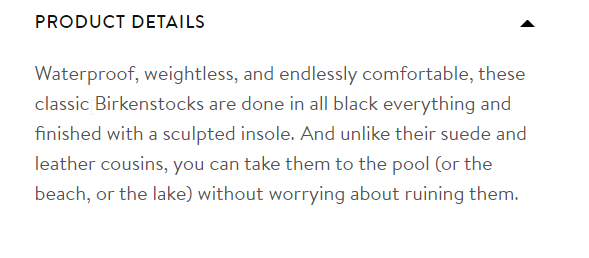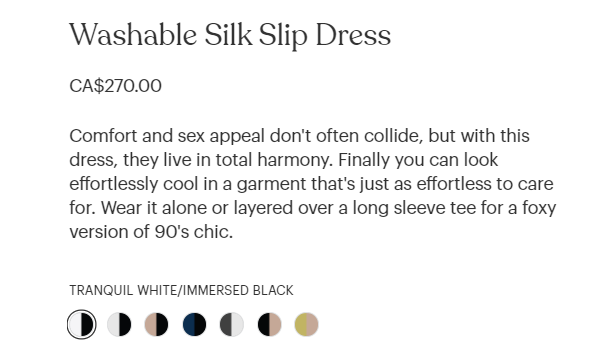Want to write killer eCommerce copy that gets you more attention, more customers and more money? Here are 5 tips for product descriptions that sell like crazy.
Let’s do a pop quiz, shall we?
When was the last time you purchased something online?
If you’re like most people, it was probably sometime within the last week or so…
In fact, it is estimated that 2.14 billion people are online shoppers, that’s 1 out of every 4 of us! And that number is only expected to keep rising…
Collectively, we are spending trillions of dollars a year and buying things online every single second of the day.
Okay, now think about the process you go through to purchase a product online…
It probably goes a little something like this…
Step 1: You browsed around, read product descriptions & customer reviews and made a short list of your top options…
Step 2: You decided on the one you wanted to buy based on those product descriptions & customer reviews.
Right?
With the eCommerce industry growing at such a rapid speed, more and more online stores are popping up to cash in on the action, reach a larger customer base, and scale their growth & revenue.
Which can only mean one thing… the competition is FIERCE.
So fierce that 81% of people spend time researching & browsing products online before they make a decision to buy.
So it goes without saying that if you want your eCommerce products to stand apart in the severely oversaturated market, then you need to make sure your product descriptions are, well, doing more than just… describing your product.
I know! Crazy right?!
Gone are the days of writing descriptions that simply ramble off a bunch of features and describe the product’s specifications.
If you want to stand out, then your copy needs to go deeper than the mundane need-to-know left-brain stuff…
So in this article, I’m going to cover the 5 things that all product descriptions must include to take your copy from crappy… to snappy.
Hey guys! What’s up? It’s Alex.
This blog post has been requested by the Posse community quite a few times over the past several months, and I want you to know that I HEAR YOU.
I really do write down every single suggestion you guys give me, so keep them coming and make sure to give me a comment up down below if you’ve been waiting for this one…
And if you’re new to the crew—welcome!
I put out a new copywriting, marketing, or freelancing tutorial every single week. So if you want to learn the hottest strategies, tips, and techniques that are working in the industry today, then be sure to subscribe and hit that bell to be notified when my next tutorial goes up.
Alright now when it comes to eCommerce entrepreneurs, there’s a pretty big misconception that copywriting comes secondary to product imagery and demonstration…
And while those are hugely important, by half-assing your copy, you’re missing out on a huge opportunity to boost conversions.
So here are the 5 things you need to do for product descriptions that don’t suck…
1. Address Your Avatar’s Needs & Desires
Knowing your customer avatar will always, always, always be one of the most important things that you can do as a copywriter or business owner.
Whether you’re writing ads, emails, or product descriptions – you need to know what your ideal customer wants, how they like to be spoken to, and what types of messages they really resonate with.
Do they want to know all of the information and specs or just the necessities?
Do they want a little sass and humor or are they more direct and to the point?
Painting a crystal clear picture of who your customer avatar is, and writing your product description as if you’re speaking directly to them is one of the biggest tricks in writing copy that converts like crazy.
Let’s look at these two examples for Birkenstock sandals.
This one directly from the Birkenstock website is honestly pretty dry, lacking personality, and very to the point. If Birkenstock knows their customer avatar, they aren’t doing a great job of speaking directly to them.
Versus this product description, for the exact same sandal, being sold through Goop’s eCommerce site. Goop is communicating the same things, but in a way that’s more relatable to their customer avatar.
Especially the line “And unlike their suede and leather cousins, you can take them to the pool (or the beach, or the lake) without worrying about ruining them.” They are speaking directly to one of their customer’s key concerns.
2. Bennies Over Features
So after you know how to talk to your audience, you need to decide which features and bennies (aka benefits) you want to include in the product description…
And the answer is not anything and everything!
When writing product descriptions, you don’t have a lot of space to work with. So that means you really need to put your copywriter cap on and narrow in on the features that are most compelling.
These are the things that make your product unique, help you stand apart from the competition, and make your customer think “Ooooo, I have to have this!”
The BEST way to do this is to talk about bennies – not features!
As a general rule, most shoppers don’t only care about WHAT the product is. They care about HOW it can help them, what problem it solves, and what they’ll get out of it.
Remember, most eCommerce product pages have an entire section that includes specifications – and THAT’S where you can include the important need-to-know features.
But make that product description as juicy as possible.
Here’s a good example from Lunya.
Not only are they addressing the mental conflict that some women feel when it comes to feeling comfortable OR feeling sexy… they also give relatable meaning behind each of their core features.
- Thermoregulating—so you can maintain a comfortable body temperature
- Machine Washable—so you can throw it in the machine and forget it
- Pockets—for all the essentials
- And an adjustable t-back—for a perfect fit, every time.
If you need help turning your features into benefits, you can grab a free copy of my Features-To-Benefits Converter right here.
3. Captivate With A Killer Hook
In the words of advertising tycoon, David Ogilvy…
Nobody was ever bored into buying a product.”
And he’s right! I see boring product descriptions EVERYWHERE I look. Especially on Amazon (you’ve seen the ones I’m talking about).
Now, I’m not picking on Amazon. But to me, the way they do product descriptions just doesn’t make sense.
With all the boring stuff up top, and to see the copy that’s actually any good you have to scroll all the way to the bottom, past all the other products vying for your attention and drastically hurting your chances of conversion……
I don’t get it.
In this example, you can clearly see the difference between the copy that’s at the top…
Comapred to this copy that is lower on the page…
Now that’s a great hook!
So going the extra mile to make sure your product descriptions lead with a captivating and engaging hook can make all the difference in a customer choosing you instead of your competition.
Remember, you want your customers to feel like you understand what they need and how your product is the solution they’ve been looking for!
4. Declutter
When it comes to product descriptions, less is more.
No matter how captivating your copy is, most people won’t take the time to read a lengthy description. Instead, they’ll likely scan through the information and make a quick decision on if this product is a good option for them.
Because of this, it’s important to not just keep the length of your copy short… but to also consider formatting and readability.
Break up your description into easy-to-read sections, bullet points, or paragraphs.
When it comes to copywriting, run-on sentences and long paragraphs are always a big no-no and product descriptions are no different.
Take this example from Moleskine.
They have the main product description here in larger font, this is where they’re really doing the selling—by speaking to your emotional wants, desires, and needs.
And over here on the left, they’ve included all the product specifications that a consumer might want to know… but in a way that doesn’t distract, is easy to read, and quick to skim.
I also cannot stress this enough… make sure your copy is optimized for mobile!
The formatting might look great on a desktop, but how does it look on mobile? Remember that 45% of all eCommerce purchases are made from mobile devices!
5. End With Keywords
No eCommerce product page is complete without including some SEO keywords to increase the chances of your product showing up in a Google search.
So AFTER I’ve written my product description and features, I then go through and add in relevant keywords where it makes the most sense…
Now, a word of caution on this… you don’t want to overdo it with the keywords. It’s important to include them strategically, but what’s more important is that your title and description MAKE SENSE.
Never sacrifice quality, readability, or compelling copy for extra keywords.
So use them. But use them wisely.
Alright now here’s a recap of my copywriting tips for writing killer product descriptions… just remember your ABCDE!
- Always Address Your Avatar
- Bennies Over Features
- Captivate With A Compelling Hook
- Declutter
- End With Keywords










